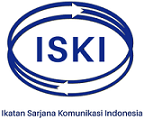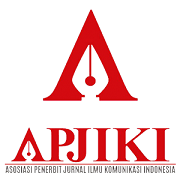- Focus and Scope
- Section Policies
- Peer Review Process
- Open Access Policy
- Publisher
- Article Processing Charge
- Archiving
Focus and Scope
Komunikologi : Jurnal Pengembangan Ilmu Komunikasi dan Sosial memfokuskan pada kajian, pengembangan teori, terapan/aplikasi teori Komunikasi baik berupa hasil penelitian maupun gagasan konseptual.
Ruang lingkup : Komunikasi politik, komunikasi pembangunan, komunikasi publik, media dan teknologi komunikasi, Komunikasi pemasaran, Komunikasi pendidikan, Komunikasi antar dan lintas budaya, Komunikasi organisasi, kelompok, dan interpersonal.
Section Policies
Articles
Peer Review Process
After a manuscript has been submitted, it will an initial review of the manuscript by the editor of Komunikologi: Jurnal Pengembangan Ilmu Komunikasi dan Sosial. A manuscript will be reviewed to see the suitability of page formats, images, tables, cites, and reference lists as well as systematics article generation. The plagiarism element check is conducted through the Plagiarism CheckerX.
The editor will decide whether the manuscript in accordance with the scope and focus and proper to give to the reviewer. Sometimes, editors may recommend revision before submitting for review. This initial review of activities usually takes a week. Submissions that pass the initial review will be assigned to a reviewer. Based on the reviewer's recommendation, the editor will first make editorial decisions.
There are five possible editorial decisions to a manuscript: (1) be accepted; or (2) be revised; or (3) be re-submit; or (4) be sent to another publisher, or (5) be rejected.
The review process is done for 4-8 weeks. If desired, the reviewer may request to be reviewed again after the author revises his article. The decision about whether the article is accepted or not, fully in the authority of the Managing Editor based on recommendations from reviewers.
Open Access Policy
Open Access Policy
Komunikologi Open Access Policy
This journal provides immediate open access to its content on the principle that making research freely available to the public supports a greater global exchange of knowledge.
Komunikologi provides immediate open access to its content on the principle that making research freely available to the public supports a greater global exchange of knowledge, meaning:
- everyone has free and unlimited access to the full-text of articles published in this journal; manuscripts are freely available without subscription or price barriers
- papers are immediately released in open access format (no long waiting periods),
Advantages of Open Access for Authors
- High Visibility and High Availability - free and unlimited accessibility of the publication over the internet without any restrictions.
- Open Access publications are more frequently cited due to their high publicity and availability.
- Publications are also more easily searchable in search engines and indexing databases.
- Less Costly - the cost of editorial processing and editing fee of each accepted paper is charged to authors' institutes or research funding agency.
- Rapid Publication - accepted papers are immediately published online.
Publisher
Publisher
Fakultas Ilmu Sosial UIN Sumatera Utara Medan
Sponsored by
UIN Sumatera Utara Medan
Article Processing Charge
Komunikologi: Jurnal Pengembangan Ilmu Komunikasi dan Sosial does not charge any fee for article submission, processing, or publication.
Archiving
This journal utilizes the LOCKSS system to create a distributed archiving system among participating libraries and permits those libraries to create permanent archives of the journal for purposes of preservation and restoration. More...






























